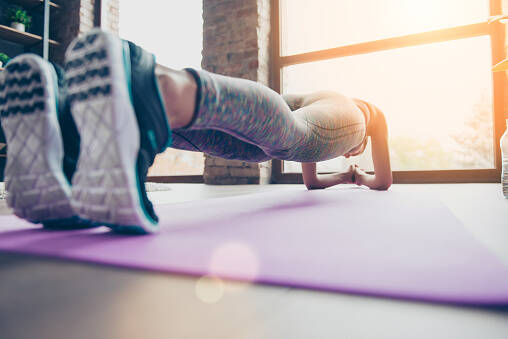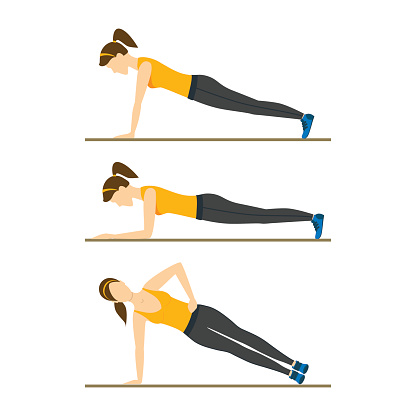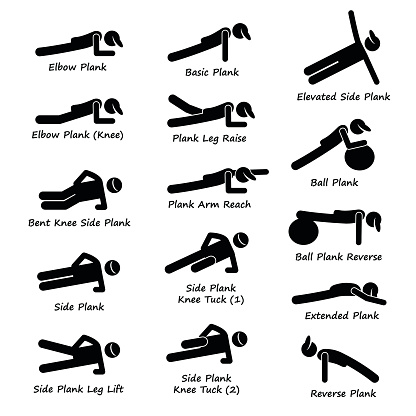- rehabilacia-poprad.sk - rehabilitation exercises for deep stabilization system
- self.com - 12 Plank Exercises That Will Fire Up Your Entire Core
- healthcorps.org - 7 Health Benefits of Plank Exercises (+5 Plank Variations You Should Know)
Is plank more effective than crunches? How to practice it correctly?

The plank is an essential exercise for strengthening the deep stabilization system of the body. It is a suitable alternative to crunches. Can it be true that it is even better?
Article content
The question is: Is planking more effective than crunches?
First of all, it is more complex. Last but not least, it exercises the deep stabilizing system of the body, the "core".
If our "core" is in poor condition, it doesn't function as the basic support of the body. It is also needed as a protection for the spine.
The superficial muscles start to take over the work of the core.
These become overloaded, creating muscle imbalances and associated problems over time. For example, back pain, neck pain, shoulder muscle overload, spinal blockages and more.
Also read the article on what will help with back and cervical spine pain.
Plank, its effects and advantages over crunches
When squats are performed incorrectly for a long time, the hip muscles often shorten. This results in pain in the sacral and lumbar spine.
Another threat is undue pressure on the spine and strain on the intervertebral discs.
If we focus only on the crunches, we strengthen the transverse abdominis muscle the most. It belongs to the group of external muscles.
By strengthening it, the deep muscles begin to weaken.
However, if we engage the deep core muscles, the external muscles are activated.
In contrast, only a small group of muscles is involved in the crunches.
During the planche exercise, the muscles of the front of the body, the sides of the abdomen, the back and also the gluteal muscles are involved.
This implies two things.
Focusing training only on the direct abdominal muscles when doing crunches is incorrect.
Well, this makes it clear that we need to train the "core" of the body. Our deep stabilization system.
How do we do that, you ask?
You can do it with a plank.
What do you learn next in this article?
What kind of plank is good to practice?
How to properly practice plank?
Plank and core support exercises.
So the effects of the plank are clear.
It exercises the deep stabilisation system, the "core" of the body. This also involves the external muscles in the exercise.
The balance of these muscle parts is created.
The centre of the body and the muscles of the spine are strengthened.
This is the basis against back pain and musculoskeletal problems.
The plank is definitely more effective than classic abdominal exercises.
This raises the basic question.
Why is it good to practice plank?
Answer:
It is good to practice plank to strengthen the deep stabilization system of our body.
It has already been mentioned so many times in this article.
But what exactly is it?
If we are to practice plank, we need to know something more.
The deep stabilizing system or "core" is made up of these muscles:
- the deep muscles of the spine
- the pelvic floor muscles
- the transverse abdominis muscle
- the internal oblique abdominal muscles
- diaphragm
These are the muscles that are deeper in the torso. They form a kind of inner shell of the abdominal cavity. They actually encircle the inner perimeter of the abdomen.
A firm midsection is important in all body movements.
It acts as a firm support. It stabilizes the spine and protects it from the forces acting on it.
Whether these forces are externally applied or caused by our physical activity.
And if our activity is minimal or nonexistent, bad habits can develop that affect our musculoskeletal system. Examples include:
- slouching when sitting
- overloading and shortening of the external muscle groups
- muscle imbalances
However, you don't have to practice plank only if problems have already arisen.
Why wait for a problem when you can prevent it?
Practicing the plank is a very sensible thing to do as a preventative measure. It is better to practice when there is no pain.
Then things go easier.
In the following table, we list the benefits of planck exercises and movements that engage the core of the body
| What we can achieve by doing planks | Movements performed using the core of the body |
|
|
The core of the body is involved in virtually every movement. Even swimming.
There is probably no activity in which the muscles of the internal stabilization system are not involved.
Thank you, Plank, for knowing you!
How to practice plank correctly?
Plank means "plank" in English.
That's what our body should look like when we do it. Firm as a board.
We start in a position like we're going to do the old-fashioned plank. That's the forward bend position. In other words, we're leaning on our outstretched arms.
We touch the floor with the tips of our toes. The distance between them is the width of our shoulders.
Slowly lower ourselves onto elbows that are the same distance apart as our feet.
So we touch the floor with our forearms and the toes of our feet.
The forearms are at a 90-degree angle with the shoulders. We do not move the elbows backwards under the torso or in the opposite direction.
We should not have the shoulder blades sticking out. This can be eliminated by turning the hands to the back of the hands. That is, with the open palm facing up.
If anyone is uncomfortable with this position, turn the hands to the outside of the palms. On the outside of the wrist joint. Where the little finger is.
Then we can also join the hands in the palms. But the elbows always stay apart.
We're strengthening the whole body.
We straighten our back so we don't hunch over.
We don't bend our knees, our legs are stretched out. The abdomen and buttocks are firm.
Don't bend at the hips or push the buttocks up too far.
The body is tight and firm. We push our elbows against the feet, but we don't make any movement, we just push.
The head and neck are aligned with the body, so we look directly at the ground below us. We actively stretch the neck.
Now we are straight and firm as a board.
So the chest, abdomen, pelvis and knees don't drop. We keep them straight and firm.
We breathe naturally, but we try to breathe into the abdomen, i.e. diaphragmatically.
It is better to push the buttocks out slightly, as if they should drop lower. The body is then more tense and the lumbar spine does not suffer.
Those who are not satisfied with the classic conventional plank can try the so-called "hardstyle plank".
This is a harder version of the plank. The more technically proficient you practice it, the less you can stand.
Take the classic plank position, but move the elbows slightly forward and closer together. Lower the pelvis and raise the buttocks higher. This pushes the tailbone towards the navel. Strengthen the abdominal and thigh muscles. Contract the gluteal muscles as much as possible. Pull the elbows under the body towards the legs. The ankles do not move.
Breathe shallowly behind the tightened abdomen.
The base is narrower in this case. The core muscles are then activated much more.
We try to stay like this for 5 to 15 seconds.
For the classic plank, we try to hold like this:
- Beginners - 30 seconds
- Intermediate - 60 seconds
- advanced - 90 seconds
But you have to start gradually. At first, one plank a day is enough. It doesn't even have to be 30 seconds. Ten is enough.
Gradually increase the length and number of plank. For example, two repetitions of 15 seconds.
If you can get to 3 reps of 30 to 60 seconds, that's a good base for practicing different sets and techniques of planks.
Plank and core exercises
There are two versions of the plank.
The classic, conventional, upright lying plank. It has two versions.
On outstretched elbows (the so-called "full plank") or on the forearms as a "low plank".
The other version is the so-called side plank, which is performed with the body turned sideways to the mat.
It can also be practiced in the same way, but this time with only one upper limb extended or resting on the forearm.

There are many exercises that can be created with your own imagination.
They can be performed with the upper or lower body resting on a raised mat. For example, on a gymnastic ball.
All these exercises will give us a good workout for our core.
It will become stronger and our body more stable and coordinated.
A strong core helps to keep the body balanced, for example when slipping.

If we are already at the stage that the 60-second plank is not a problem for us, we can choose a specific set of exercises.
This can be done, for example, with the tabata system.
In this article you will learn more about tabata.
Interesting resources










